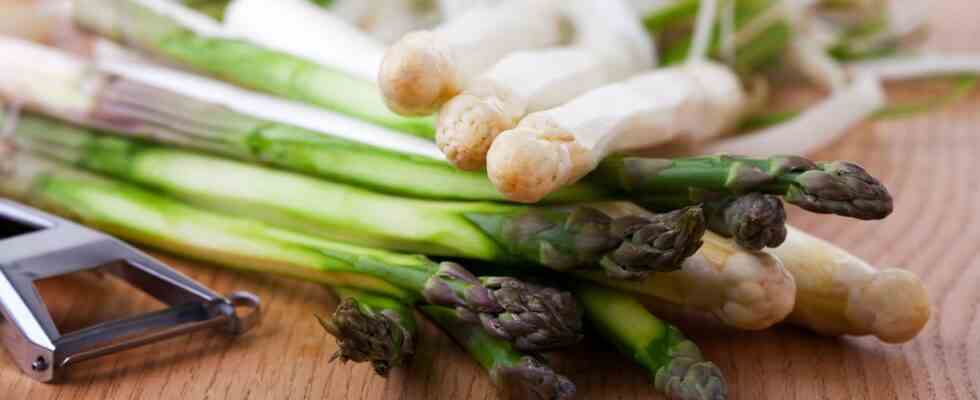green and white
Peel the asparagus correctly: How to prepare the seasonal vegetables
Depending on the type of asparagus, it must be peeled
© bernjuer / Getty Images
Depending on the weather, the first asparagus grow in Germany between March and April – and the last traditionally on June 21st. Whether the stalks need to be peeled before eating depends on the variety. The following tips tell you what else you need to consider when preparing.
Green asparagus has a thin skin that softens when cooked and can therefore be eaten without any problems. However, the ends can be woody and should therefore be cut off before cooking or searing – an inch or two is enough. White asparagus, on the other hand, must be peeled because it has a hard and fibrous outer shell that is inedible. Just a few scraps of peel are enough to spoil the enjoyment of the noble vegetable. It is all the more important that you proceed carefully when peeling. Below you can find out how easy it is to do this and which kitchen utensils are helpful.
Peeling white asparagus: This is how you do it correctly
It is important that you only peel the asparagus when you want to prepare it (and then eat it). Otherwise, the stalks would lose moisture, dry out, and lose flavor. To remove the peel, it is best to use a special one asparagus peeler, which should make your work easier. Please note the following tips:
- Place the white asparagus on a board and always remove the peel from top to bottom – i.e. from the asparagus tip to the end of the cut.
- The asparagus heads themselves do not need to be peeled, as they become soft enough to eat as they cook.
- Be careful not to put too much pressure on the poles as they are not very flexible and can break easily.
- Be extra thorough when peeling so you catch all the woody fibers.
- If some areas are particularly woody, you can carefully remove these “eyes” with a knife.
- Finally, cut off the woody end of the asparagus spear with a sharp knife, preferably one to two centimetres.
- Then boil the peeled sticks in hot (salt) water, a special one is suitable for this asparagus pot.
And another tip: Don’t throw away the peels, as you can make a nice broth out of them – for example as a basis for a cream of asparagus soup.
Preparing green asparagus: this is important to note
As already mentioned, green asparagus usually does not need to be peeled before preparation. However, if the stalks are particularly thick, the bowl may be a little woodier – especially in the lower third. Here it makes sense to cover the lower part of the outer shell with a asparagus peeler to remove before consumption, same goes for the woody ends. Again, you can reuse the bowl afterwards if you like.
Tip: You can find even more ideas for asparagus dishes in this one recipe book.
Storing asparagus: this way it will last longer
If you’ve bought fresh asparagus, whether green or white, but want to refrigerate for a few more days, the spears need to be kept moist. The best way to do this is to take a clean tea towel, hold it under running water and then wring it out well. Then wrap the unpeeled asparagus in the damp cloth and keep it in an (open) container. If you don’t have a tea towel to hand, two layers of kitchen paper serve the same purpose.
Alternatively, the sticks can easily be frozen to give them a longer shelf life – or to eat later. In this case, you should peel the asparagus so that you can simply put them in boiling water and prepare them frozen at a later time.
Tip: Secure discounts now – Here you will find an overview of current offers from OTTO.
You might also be interested in:
This article contains so-called affiliate links. Further information are available here.



